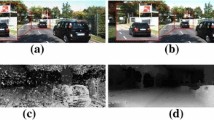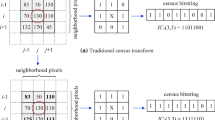Abstract
Every stereovision application must cope with the correspondence problem. The space of the matching variables, often consisting of spatial coordinates, intensity and disparity, is commonly referred as the data term (space). Since the data is often noisy a-priori, preference is required to result a smooth disparity (or piecewise smooth). To this end, each local method (e.g. window correlation techniques) performs a regularization of the data space. In this paper we propose a geometric framework for anisotropic regularization of the data space seeking to preserve the discontinuities in this space when filtering out the noise. On the other hand, the global methods consider a non-regularized data term with a smoothing constraint imposed directly on the disparity. This paper also proposes a new idea where the data space is regularized in a global method prior to the disparity evaluation. The idea is implemented on the state of the art variational method. Experimental results on the Middlebury real images demonstrate the advantages of the proposed approach.
Similar content being viewed by others
References
Alvarez, L., Deriche, R., Sànchez, J., Weickert, J.: Dense disparity map estimation respecting image discontinuities: a pde and scale-space based approach. J. Vis. Commun. Image Represent. 13, 3–21 (2002)
Ben-Ari, R., Sochen, N.: A general framework and new alignment criterion for dense optical flow. In: Proc. IEEE Conference on Computer Vision and Pattern Recognition, vol. 1, pp. 529–536 (2006)
Boboick, A.F., Intille, S.S.: Large occlusion stereo. Int. J. Comput. Vis. 33(3), 181–200 (1999)
Boykov, Y., Veksler, O., Zabih, R.: A variable window approach to early vision. IEEE Trans. Pattern Anal. Mach. Intell. 20(12), 1283–1294 (1998)
Brook, A., Kimmel, R., Sochen, N.: Variational segmentation of color images. J. Math. Imaging Vis. 18(3), 247–268 (2003)
Brown, M.Z., Burschka, D., Hager, G.D.: Advances in computational stereo. IEEE Trans. Pattern Anal. Mach. Intell. 8(25), 993–1008 (2003)
Brox, T., Bruhn, A., Papenberg, N., Weickert, J.: High accuracy optical flow estimation based on a theory for war**. In: Proc. of 8th European Conference on Computer Vision. Lecture Notes in Computer Science, vol. 3024, pp. 25–36. Springer, Berlin (2004)
Hartley, R., Zisserman, A.: Multiple view geometry in computer vision, 2nd edn. Cambridge University Press, Cambridge (2003)
Kanade, T., Okutomi, M.: A stereo matching algorithm with an adaptive window: theory and experiments. IEEE Trans. Pattern Recognit. Mach. Intell. 16(9), 920–932 (1994)
Kimmel, R.: 3D shape reconstruction from autostereograms and stereo. J. Vis. Commun. Image Represent. 13, 324–333 (2002). Special issue on PDEs in Image Processing, Computer Vision, and Computer Graphics
Kimmel, R., Malladi, R., Sochen, N.: Images as embedded maps and minimal surfaces: movies, color, texture, and volumetric medical images. Int. J. Comput. Vis. 39(2) 111–129 (2000)
Klaus, A., Sormann, M., Karner, K.: Segment-based stereo matching using belief propagation and self-adapting dissimilarity measure
Kolmogorov, K., Zabih, R.: Computing visual correspondence with occlusions using graph cuts. In: Proc. ICCV, vol. 2, pp. 508–515
Kreyszig, E.: Differential Geometry. Dover, New York (1991)
Lei, C., Selzer, J., Yang, Y.H.: Region tree based stereo using dynamic programming optimization. In: Proc. CVPR, vol. 2, pp. 2378–2385 (2006)
Leung, C., Appleton, B., Lovell, B.C., Sun, C.: An energy minimization approach to stereo-temporal dense reconstruction. In: Proc. ICPR, vol. 4, pp. 72–75 (2004)
Mansouri, A.R., Mitiche, A., Konard, J.: Selective image diffusion: application to disparity estimation. In: Proc. IEEE International Conference on Image Processing, vol. 3, pp. 114–118 (1998)
McIntosh, J.H., Mutch, K.M.: Matching straight lines. Comput. Vis. Graph. Image Process. 43, 386–408 (1998)
Medioni, G., Nevatia, R.: Segment based stereo matching. Comput. Vis. Graph. Image Process. 31(3), 2–18 (1985)
Mumford, D., Shah, J.: Optimal approximations by piecewise smooth functions and associated variational problems. Commun. Pure Appl. Math. 42, 577–684 (1989)
Nasrabadi, N.M.: A stereo vision technique using curve-segments and relaxation matching. IEEE Trans. Pattern Anal. Mach. Intell. 14, 566–572 (1992)
Ohta, Y., Kanade, T.: Stereo by intra-and inter-scale search using dynamic programming. IEEE Trans. Pattern Anal. Mach. Intell. 7, 139–154 (1985)
Middlebury Stereo Vision Research Page. http://cat.middlebury.edu/stereo/
Pollard, S.B., Mayhew, J.E.W., Frisby, J.P.: A stereo correspondence algorithm using a disparity gradient constraint. Perception 14, 449–470 (1985)
Pollefeys, M., Koch, R., Van Gool, L.: A simple and efficient rectification method for general motion. In: Proc. 7th International Conference on Computer Vision, pp. 496–501 (1999)
Polyakov, A.M.: Quantum geometry of bosonic strings. Phys. Lett. B 103, 207–210 (1981)
Robert, L., Deriche, R.: In: Dense depth map reconstruction: a minimization and regularization approach which preserves discontinuities. Lecture Notes in Computer Science, vol. 1064, pp. 439–451. Springer, Berlin (1996)
Sapiro, G., Ringach, D.: Anisotropic diffusion of multi-valued images. In: 12th International Conference on Analysis and Optimization of Systems: Images, Wavelets and PDE’s, vol. 219
Scharstein, D., Szeliski, R.: Stereo matching with non-linear diffusion. Int. J. Comput. Vis. 28(2), 155–174 (1996)
Scharstein, D., Szeliski, R.: A taxonomy and evaluation of dense two frame stereo correspondence algorithms. Int. J. Comput. Vis. 47(1), 7–42 (2002)
Schmid, C., Zisserman, A.: The geometry and matching of curves in multiple views. In: Proc. European Conference in Computer Vision, pp. 104–118 (1998)
Shah, J.: A nonlinear diffusion model for discontinuous disparity and half-occlusions in stereo. In: Proc. CVPR, pp. 34–40 (1993)
Slesareva, N., Bruhn, A., Weickert, J.: Optical flow goes stereo: a variational method for estimating discontinuity-preserving dense disparity maps. In: Kropatsch, W., Sablatnig, R., Hanbury, A. (eds.) Pattern Recognition, Proc. 27th DAGM Symposium DAGM, vol. 3663, pp. 33–40 (2005)
Sochen, N.: Stochastic processes in vision: from Langevin to Beltrami. In: Proc. of International Conference on Computer Vision, vol. 1, pp. 288–293 (2001)
Sochen, N., Kimmel, R., Bruckstein, A.M.: Diffusions and confusions in signal and image processing. J. Math. Imaging Vis. 14(3), 237–244 (2001)
Sochen, N., Kimmel, R., Malladi, R.: From high energy physics to low level vision. Technical report, UC Berkeley CA 94720, August 1996
Sochen, N., Kimmel, R., Malladi, R.: A general framework for low level vision. IEEE Trans. Image Process. 7, 310–318 (1998)
Spira, A., Kimmel, R., Sochen, N.: Efficient Beltrami flow using a short-time kernel. In: Proc. of the 4th International Conference on Scale-Space Methods in Computer Vision (2003)
Sun, J., Li, Y., Kang, S.B., Shum, H.-Y.: Symmetric stereo matching for occlusion handling. In: Proc. of International Conference on Computer Vision and Pattern Recognition, pp. 399–406 (2005)
Sun, J., Shum, H.-Y., Zheng, N.N.: Stereo matching using belief propagation. In: Proc. of European Conference on Computer Vision, pp. 510–524 (2002)
Tschumperlè, D., Deriche, R.: Vector valued image regularization with PDE’s. A common framework for different applications (2003)
Veksler, O.: Stereo corresponding with compact windows via minimum ratio cycle. IEEE Trans. Pattern Anal. Mach. Intell. 24(12), 1654–1660 (2002)
Veksler, O.: Fast variable window for stereo correspondence using integral images. In: Proc. IEEE Conference on Computer Vision and Pattern Recognition, vol. 1, pp. 556–561 (2003)
Venkateswar, V., Chellapa, R.: Hierarchical stereo and motion correspondence using feature grou**. Int. J. Comput. Vis. 15, 245–269 (1995)
Weickert, J.: Anisotropic Diffusion in Image Processing. Teubner, Stuttgart (1998)
Yezzi, A.: Modified curvature motion for image smoothing and enhancement. IEEE Trans. Image Process. 7, 345–352 (1998)
Yoon, K., Kweon, I.: Locally adaptive support-weight approach for visual correspondence search. In: Proc. CVPR, vol. 2, pp. 924–931 (2005)
Author information
Authors and Affiliations
Corresponding author
Rights and permissions
About this article
Cite this article
Ben-Ari, R., Sochen, N. A Geometric Approach for Regularization of the Data Term in Stereo-Vision. J Math Imaging Vis 31, 17–33 (2008). https://doi.org/10.1007/s10851-008-0066-5
Received:
Accepted:
Published:
Issue Date:
DOI: https://doi.org/10.1007/s10851-008-0066-5




